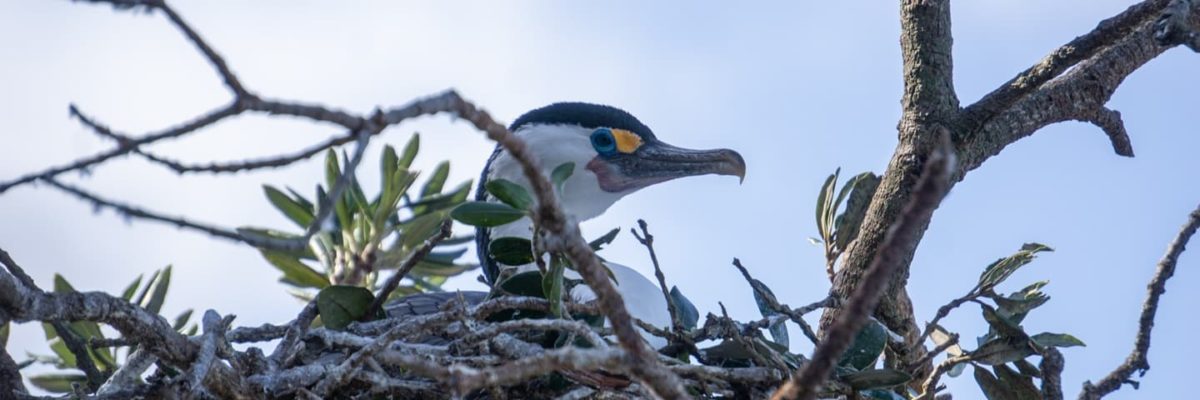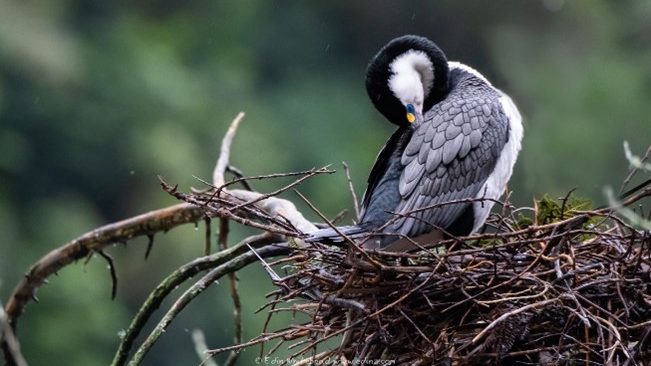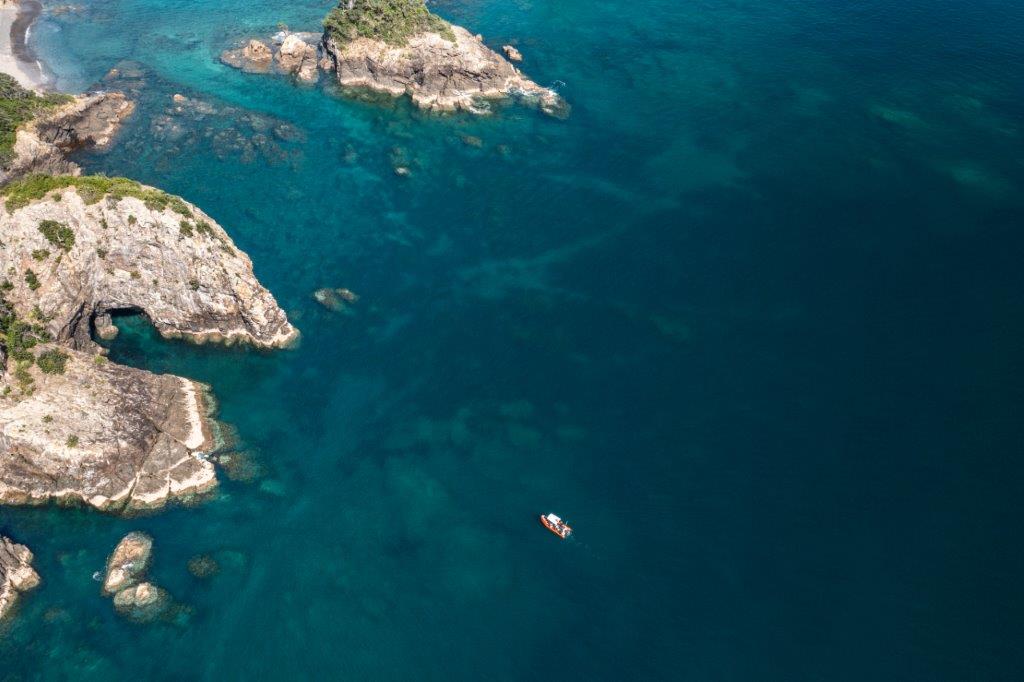The Noises hold a very special interest for seabird lovers. Being home to at least…

Pied shags, an underappreciated gem of the Gulf
A familiar feature of The Noises and wider Hauraki Gulf is colonies of pied shags kāruhiruhi nesting in trees, on coastal cliffs or islands. Getting close up to these colonies reveals the mauri (life force) with birds leaving from or returning to their bundled stick nests, uttering croaking calls and the replies of chicks begging for food. But watch out getting too close as the rocks below are splattered white with guano from above and have the rich smell of “life”.
Perhaps it is because we are so used to them but pied shags are one of the more underappreciated of the gulf seabird treasures. The pied shag Phalacrocorax varius is an attractive large black and white shag that lives in coastal areas across much of New Zealand. Adults in breeding plumage are particularly striking with a blue eye ring offsetting yellow in front of the eye and pink or red at the base of the beak. Pied shags nest mostly in small colonies and, unusually for a seabird, can breed across the year with peaks in Autumn and Spring. At The Noises a small, pied shag colony of 30-50 birds has persisted in clifftop Pohutukawa trees on Ōtata, some years breeding and others not. The New Zealand population of pied shags is considered to be approximately 5000-10,000 breeding pairs.

To watch a pied shag hunting is to watch perfection in motion. Shags use their feet for propulsion underwater, keeping their wings closed unlike other gulf seabirds such as fluttering shearwaters, diving petrels, and penguins that fly underwater with wings outstretched. Driven by foot power, birds are agile, capable of chasing and capturing fish in dives up to 20 meters deep, and staying under for several minutes or more. They are also adaptable hunters, taking a broad range of fish prey. However, this hunting ability and adaptability is causing big trouble for pied shags particularly in relation to fishers. In the past ten years, pied shags have become increasingly bold in their interactions with fishing boats in the inner gulf as they have learned to get a free feed of fish. Birds will wait for bait or undersize fish, snapper in particular, to be released over the side and then pursue and catch the disorientated fish. Examples of this behavior and of fishers feeding snapper to birds can be found on Youtube (search shag or bird eats fish NZ).
Whilst fishers may think they are being kind feeding shags, they are actually putting the birds in mortal danger by making them think fishing boats equal food. These big shags can be brazen around the back of the boat and as a result, end up getting hooked. Karen Saunders at Bird rescue Waiheke reports that since 2018, 44 pied shags have been brought in having been found or caught entangled in fishing hooks and line. Of these birds, nine died and a further five had to be euthanized as a result of their injuries. Unfortunately, this is likely the tip of the ice berg with dead entangled shags frequently found around the gulf. At The Noises tangled shags are a frequent occurrence though the most traumatizing sight has been the fate of shags who return to their colony with the hook and fishing line trailing. These birds become entangled in branches and end up weakened and hanging from the branches to die in slow agony.
The team at Bird Rescue Waiheke work to save one of many pied shags injured through getting tangled in fishing gear ©Karen Saunders

So, how can we protect these beautiful birds? Well, the first thing to do is don’t catch them; don’t feed pied shags when you are fishing, either with bait or undersized fish being returned to the water. When fishing from our boat we use a small buoy attached to a length of rope to throw near birds and scare off persistent ones, particularly when you are about to release an undersize snapper. If birds are too persistent and the risk of catching them is high, consider changing fishing spots. If you do hook a bird do not cut the line. Rather, retrieve the bird and catch it, making sure to secure the head and bill first – shags will defend themselves, can strike with their bill further and faster than you might think and will often try and strike the face. Once you have the bird secured cut off the fishing line but leave around 1.5 meters from the hook. If the bird cannot be disentangled, the hook removed and released immediately then secure it in a large bag, box or pillow case in a cool shady place and contact Karen Saunders at Native Bird Rescue on Waiheke Island (0204739464, www.nativebirdrescue.nz). Karen and the team are available 24/7 and will come and meet boats from most places around the Waiheke coast. See also this piece by Young Ocean explorers for more advice.
Lastly, it’s important to remember that pied shags are not just pesky fish thieves, they are important parts of the gulf ecosystem from which we all benefit. As predators, they maintain healthy fish populations by removing sick and weak individuals. On the shore their colonies fertilize nearshore reefs, enhancing seaweed growth that in turn provides habitat for an abundance of marine species including the ones we like to catch. Next time you see one have a good watch and appreciate and care for these beautiful and cheeky birds.
Matt Rayner is the Curator of Land Vertebrates at Tāmaki Paenga Hira Auckland War Memorial Museum. Like the seabirds he studies, he’s a regular visitor to The Noises.





